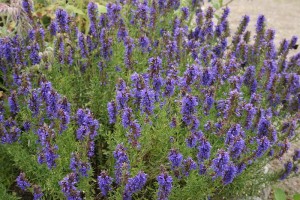 Hyssop (Hyssopus officinalis) is an herb that I would like to get to know better. Not anise hyssop (Agastache foeniculum). That’s an entirely different herb. Nor the holy herb referred to in the Bible used to cleanse sacred spaces. That’s a mistranslation. No, the hyssop growing in my garden is a woody shrub that is native to the Middle East, Southern Europe and Caspian Sea area. It’s a tough little plant. Despite its Mediterranean origins, it is hardy from Zone 3 through Zone 10. It’s drought tolerant, growing best in well drained soils although it can grow in sandy or chalky soils. And, like most herbs it prefers full sun, but it can also tolerate a little shade.
Hyssop (Hyssopus officinalis) is an herb that I would like to get to know better. Not anise hyssop (Agastache foeniculum). That’s an entirely different herb. Nor the holy herb referred to in the Bible used to cleanse sacred spaces. That’s a mistranslation. No, the hyssop growing in my garden is a woody shrub that is native to the Middle East, Southern Europe and Caspian Sea area. It’s a tough little plant. Despite its Mediterranean origins, it is hardy from Zone 3 through Zone 10. It’s drought tolerant, growing best in well drained soils although it can grow in sandy or chalky soils. And, like most herbs it prefers full sun, but it can also tolerate a little shade.
Hyssop can be used as a low hedge and in knot gardens because it grows to only 1 to 2 feet in height with a spread of 1 to 3 feet. It can be pruned and shaped. On the other end of the landscape spectrum, it can be grown massed or in containers. It’s really a very versatile plant!
It also has lovely flowers, commonly in blue but also pink and most rare, white. The flowers appear in late June and last through August. Butterflies find them irresistible as do honey bees. The honey produced from hyssop flowers is rich with an intense fragrance. Hyssop will self-sow itself in your garden so you might want to deadhead the flowers when they are finished.
Propagation is easy. Hyssop can be grown from seeds, cuttings and division. Seeds can be direct sown in your garden in full sun as soon as the soil warms. They can also be started in early spring in a cold frame. Plant the resulting seedlings in your garden after your last frost. Cuttings should be made June to July and rooted in a cold frame or greenhouse. Overwinter the resulting plants in the protection of your cold frame or greenhouse, planting them in your garden the following spring. Hyssop plants can be divided in either the spring or the fall.
Pruning should be done in the late spring, after the plant has finished flowering. Remove the dead flowers and any dead branches and then prune to the desired size and shape. You can continue lightly pruning your plants throughout the summer to maintain their shape but you should stop all pruning in the fall. Pruning causes new growth which needs time to harden off before winter. Pruning your plants in the fall will result in new growth that will not survive the winter.
Hyssop was traditionally used to treat coughs, colds and upper respiratory infections due to its cough suppressant and expectorant properties. The plants were harvested for their flowers, which with the leaves, were dried. It is important to note that hyssop contains thujone which in large doses causes seizures. Nowadays, we grow hyssop for its ornamental value, rather than its medicinal properties.


6 Comments on “Hyssop”
Pingback: Wintersowing Herbs - Advice From The Herb Lady
Thank you very much for this excellent advice… in the past when I’ve bought hyssop in Spring I may have pruned them then resulting in few flowers… so going to follow your advice. I bought the plant for the bees and butterflies so hoping for lots of flowers. Thanks again, Terry
Thanks! This was very helpful. My hyssop grew rather quickly and looks so nice right now! Im a little concerned about it surviving the winter. I hope that it does though….
Thanks and blessings!! Mary
Mary, as long as you live within hyssop’s growing zone, it should make it through the winter. It is a tough plant.
My Hyssop is about 4 ft tall and recently (twice) a branch has folded in half and dropped to the ground. I then had to cut if off at the bend. Why did this happen and how can I prevent it from happening again. Thank you for your help. It’s a great plant and the bees never leave it alone!
The branches get top heavy from the weight of the blooms. It is normal. Just prune it like you did and it will grow back.